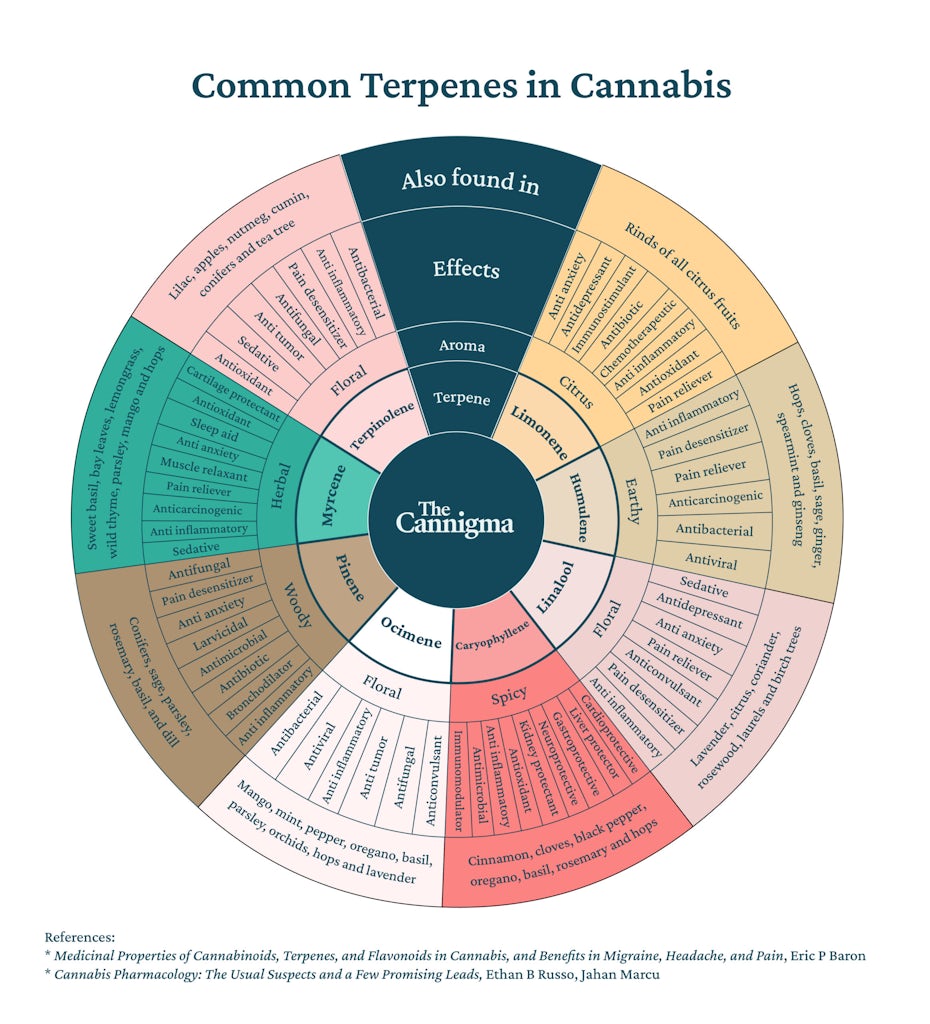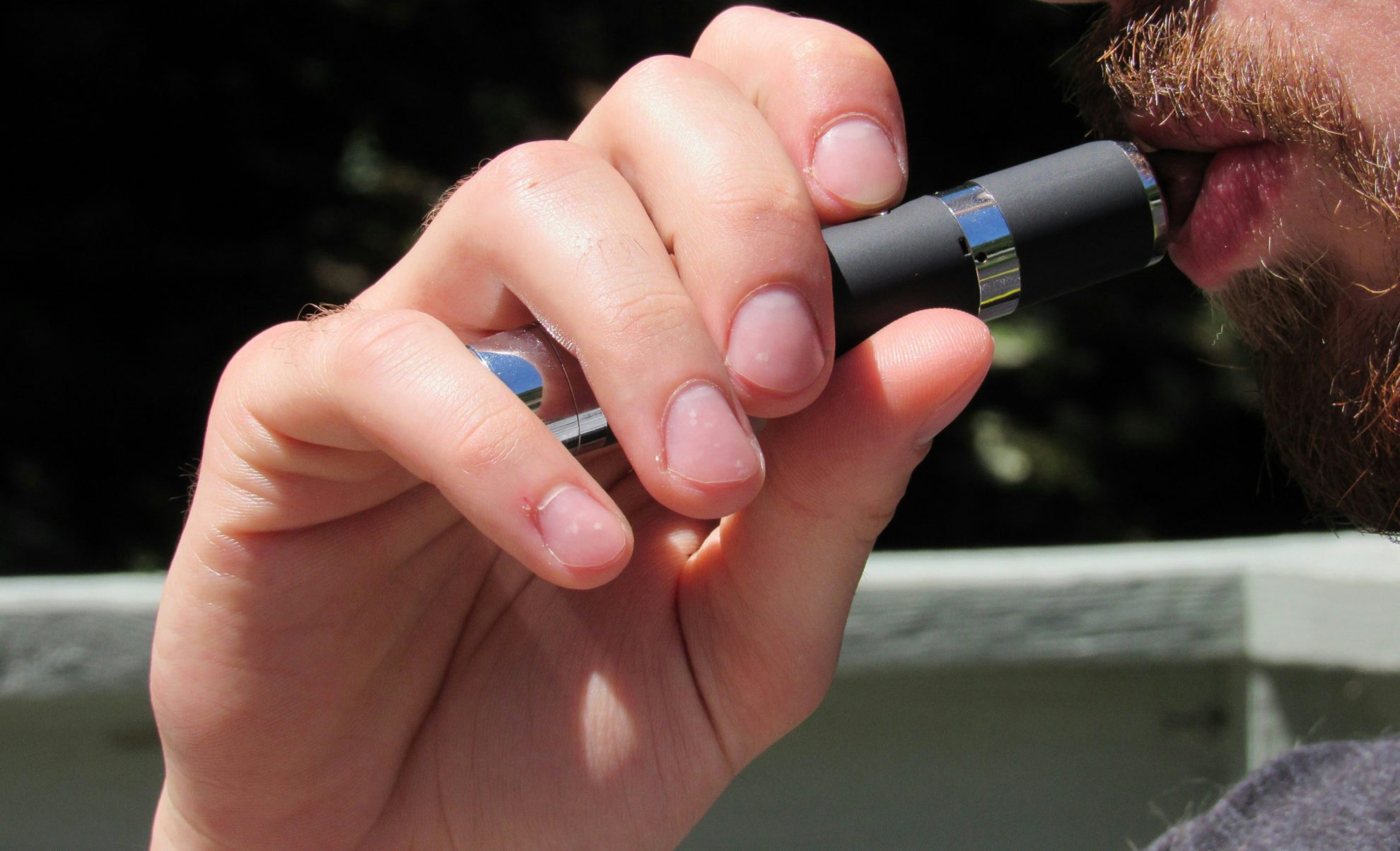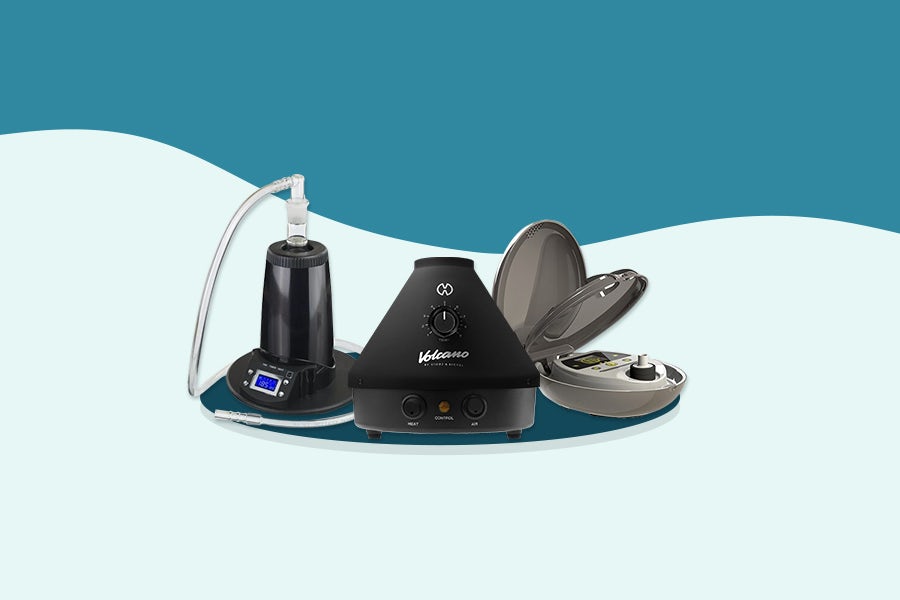One of the most common uses of medical cannabis is to treat chronic pain. In fact, modern research on cannabis and pain dates back to before 1975.
Over 10% of US adults have suffered from some degree of daily pain for at least three months, so the need for improved treatment is clear. And this is an area of ample scientific research. There have been a number of preclinical and clinical trials studying cannabis’ effects on pain. While the research points to a mostly positive effect, it’s not as simple as smoking a joint to cure yourself.
The best type of cannabis for dealing with chronic pain tends to be type I or type II strain with a terpene profile that includes linalool, pinene, beta-caryophyllene, limonene, or myrcene.
When shopping for a strain for chronic pain, look for one that matches the cannabinoid and terpene profile, not one that matches the strain name exactly. Strain names aren’t regulated and are a poor indicator of how cannabis will affect you.
Strains mentioned in this article include:
How cannabis can help with pain
To properly understand how cannabis interacts with pain, it’s important to understand what pain is. Johns Hopkins defines pain as “an uncomfortable feeling that tells you may be wrong. It can be steady, throbbing, stabbing, aching, pinching, or described in many other ways. Sometimes, it’s just a nuisance… other times it can be debilitating.”
Pain can come from many sources, like a broken bone, stomach ache, or nerve damage. Pain should arrive to signal something is wrong and leave when it’s fixed, but for some people, pain without cause persists. These people suffer from chronic pain. Chronic pain lasts for weeks, months, or even years.
One of the major reasons cannabis grew so popular with medical marijuana patients is its perceived ability to manage pain, particularly pain that other medications can’t help. Your endocannabinoid system produces endocannabinoids to help your body manage and heal from pain. 1
When this system alone can’t manage the pain, outside cannabinoids like THC can help.
THC has several properties that make it effective at treating pain:
- Reducing inflammation
- Reducing pain
- Preventing/reducing vomiting
CBD also has properties and may assist with pain relief. 2
- Anti-inflammatory – in fact it is more potent as an anti-inflammatory than THC 3
- Antiemetic
- Increasing endocannabinoid levels
Research on cannabis and pain
- A 2015 review of 28 cannabis studies found that while medical marijuana is prescribed for ailments that do and don’t have supporting evidence, the plant can be beneficial for people suffering from chronic pain, neuropathic pain, and multiple sclerosis. 4
- A 2015 study of 279 Israeli cancer patients found that 70% of participants reported a reduction in pain and improvement in quality of life, 60% reported an increase in appetite and 50% reported a reduction in nausea. 5
- A retrospective review of 121 migraine patients in Colorado found that daily cannabis use reduced migraine frequency. The study noted that 11% of patients had a negative experience caused by patients using edibles. 6
Not only does cannabis help manage pain, but it may also help reduce dependence on opioids.
A 2016 study found that patients with chronic pain who used cannabis had a 64% reduction in opioid use, reported a better quality of life, and used fewer medications overall to manage their pain. 7
Cannabis is safer than opioids, with far fewer side effects and no risk of overdose death.
Can topical terpenes alone help with pain?

Using topical terpenes can also help alleviate your pain. Whether you realize it or not, you may already use terpenes (or technically terpene derivatives known as terpenoids) in your daily life. Many topical balms, creams, and pain patches have terpenes in them to help alleviate your pain. These terpenoids include:
- Camphor. Made from oil extracted from camphor trees, camphor oil is a common ingredient in topical pain relief products. It’s FDA approved to treat pain and itching, and you can find it in products like Vicks VapoRub and Tiger Balm.
- Menthol. Menthol is a terpenoid naturally found in mint plants, but it can also be made by scientists. It alleviates minor aches and pains with a cooling and heating sensation that distracts your mind. You can find menthol in products like Vicks VapoRub, Icy Hot, and Bengay. It is FDA approved for use in a product known as SalonPas.
How to choose cannabis for pain
When it comes to finding the right strain to deliver powerful pain relief, it’s not important whether you’re consuming a sativa or an indica. These are plant qualifiers that tell you more about the physical characteristics of the plant rather than the chemical compounds within the nugs. Strain names are also not a great indicator, as they’re not regulated and a grower can really call a strain anything they want. So what should you use?
The chemovar. Cannabis chemotypes are classifications grouped together by the dominant cannabinoid(s) in the bud.
There are three types of cannabis chemovars:
- Type I: High THC, low CBD
- Type II: Balanced THC and CBD
- Type II: High CBD, low THC
When dealing with pain, the presence of THC is often most helpful to patients with painful conditions, so a type I or type II strain is often preferred. For patients who don’t like the effects of THC, they may benefit from the presence of CBD, which can modify the high. The anti-inflammatory effects of CBD and THC are well established, and there are several other ways cannabinoids help alleviate pain and swelling. 8
Many people who suffer from chronic pain are not just looking to lessen the pain; they’re also looking for a way to escape the mindset that constant pain puts you in. THC is very helpful for this. But when working with a type I strain, it’s important to monitor your dosage, as THC has biphasic effects. 9 This means it can have different effects on your body in a low dose than in a high dose. A low dose of THC has been found to be beneficial for managing chronic pain, while high doses can make it worse. 10
However, it’s important to note that this is subjective, just as pain levels are subjective. Everyone has a unique endocannabinoid system and depending on your ECS and your pain levels, you may need a higher dose.
If you don’t like the effects of high THC strains, as many people don’t, reach for a type II strain. The THC will still be effective in reducing your pain level while the CBD content will keep you balanced.
Taking cannabis for pain
Cannabis can be consumed many ways, and some are better than others for unique managing pain.
Smoking is the fastest way to feel the effects of cannabis and relieve pain, but the high doesn’t last long. On the other hand, edibles last much longer, but it can take up to 90 minutes to feel the effects, which is not desirable if you’re trying to reduce your pain level immediately.
Managing pain with cannabis may require a multi-faceted approach, where you use an oral consumption method like capsules on a daily basis, and topical products or smoking as needed.
Best terpenes for pain
A 2021 study found that using terpenes in conjunction with cannabinoids amplifies the pain-relieving properties of cannabis. 11 These aromatic compounds have powerful pain-relieving properties of their own, and they work better together in the entourage effect.
- Pinene
- Pinene influences “multiple neurotransmitter, inflammatory and neurotrophic signals” responsible for muscle movement and pain. 12
- Pinene had the ability to meditate chemical responses to inflammation in rodent trials. 13
- A review of pinene studies found that among the many researched benefits, pinene had “strong pharmacological effects” in reducing inflammatory responses in rodent studies. 14
- Limonene
- Linalool
- Linalool acts on the somatic sensory system to block the “excitability of the sciatic nerve” as shown in a 2010 preclinical study. 17
- Linalool influences “multiple neurotransmitter, inflammatory and neurotrophic signals” responsible for muscle movement and pain. 18
- Linalool has anti-inflammatory, antihyperalgesic properties and mediates adenosine A1 and A2A receptors to aid in pain relief. 19
- Myrcene
- Beta-Caryophyllene
- Beta-Caryophyllene reduced painful stimuli through CB2 activation in a preclinical rodent study. CB2 has been identified as an important modulator of pain and inflammation response. 23
- A 2014 preclinical study called plant-based beta-caryophyllene “highly effective in the treatment of long-lasting, debilitating pain states.” 24
Finding terpene profiles on your weed can be challenging, but you can always supplement your cannabis use with essential oils. Using essential oils in addition to cannabis can help you get the benefits from the plant and from the terpenes.

Best strains for pain
When looking for strains to treat chronic pain, reach for ones that match the cannabinoid and terpene profile described here, not ones that match the exact strain names. Strain names are an unreliable indicator of how cannabis will affect you because they’re not regulated in any way. A grower can call a strain anything they like, even if it has a wildly different chemical profile from the original.
Best type I strains for pain
Many people who suffer from chronic pain reach for powerful THC-dominant strains to help relieve pain and provide a mental boost. The best type I strains for pain have limonene, linalool, myrcene, beta-caryophyllene, or pinene in the terpene profile. Strain with this profile include Do Si Dos, Acapulco Gold, and White Fire OG.
Best type II strains for pain
If you prefer to have a blend of CBD and THC, reach for a type II strain to treat your pain. This strain should still have a terpene profile that includes limonene, linalool, myrcene, beta-caryophyllene, or pinene. Strains that fit this profile include Cannatonic and Critical Mass.
Sources
- Manzanares J, Julian M, Carrascosa A. Role of the cannabinoid system in pain control and therapeutic implications for the management of acute and chronic pain episodes. Curr Neuropharmacol. 2006 Jul;4(3):239-57. doi: 10.2174/157015906778019527. PMID: 18615144; PMCID: PMC2430692.
- Xiong, W., Cui, T., Cheng, K., Yang, F., Chen, S. R., Willenbring, D., Guan, Y., Pan, H. L., Ren, K., Xu, Y., & Zhang, L. (2012). Cannabinoids suppress inflammatory and neuropathic pain by targeting α3 glycine receptors. The Journal of experimental medicine, 209(6), 1121–1134. https://doi.org/10.1084/jem.20120242
- Ligresti A, et al. From Phytocannabinoids to Cannabinoid Receptors and Endocannabinoids: Pleiotropic Physiological and Pathological Roles Through Complex Pharmacology. Physiol Rev. 2016 Oct;96(4):1593-659.
- Hill KP. Medical Marijuana for Treatment of Chronic Pain and Other Medical and Psychiatric Problems: A Clinical Review. JAMA. 2015 Jun 23-30;313(24):2474-83. doi: 10.1001/jama.2015.6199. Erratum in: JAMA. 2016 Sep 6;316(9):995. PMID: 26103031.
- Barliz Waissengrin, Damien Urban, Yasmin Leshem, Meital Garty, Ido Wolf, Patterns of Use of Medical Cannabis Among Israeli Cancer Patients: A Single Institution Experience,Journal of Pain and Symptom Management, V49 I2, 2015, Pages 223-230,ISSN 0885-3924
- Rhyne DN, Anderson SL, Gedde M, Borgelt LM. Effects of Medical Marijuana on Migraine Headache Frequency in an Adult Population. Pharmacotherapy. 2016 May;36(5):505-10. doi: 10.1002/phar.1673. Epub 2016 Jan 9. PMID: 26749285.
- Boehnke K et al, Medical Cannabis Use Is Associated With Decreased Opiate Medication Use in a Retrospective Cross-Sectional Survey of Patients With Chronic Pain, VOLUME 17, ISSUE 6, P739-744, JUNE 01, 2016
- Starowicz K, Finn DP. Cannabinoids and Pain: Sites and Mechanisms of Action. Adv Pharmacol. 2017;80:437-475. doi:10.1016/bs.apha.2017.05.003
- Calabrese EJ, Rubio-Casillas A. Biphasic effects of THC in memory and cognition. Eur J Clin Invest. 2018 May;48(5):e12920. doi: 10.1111/eci.12920. Epub 2018 Apr 2. PMID: 29574698.
- Kansagara D, O’Neil M, Nugent S, et al. Benefits and Harms of Cannabis in Chronic Pain or Post-traumatic Stress Disorder: A Systematic Review [Internet]. Washington (DC): Department of Veterans Affairs (US); 2017 Aug. EXECUTIVE SUMMARY.
- LaVigne, J.E., Hecksel, R., Keresztes, A. et al. Cannabis sativa terpenes are cannabimimetic and selectively enhance cannabinoid activity. Sci Rep 11, 8232 (2021). https://doi.org/10.1038/s41598-021-87740-8
- Weston-Green, K., Clunas, H., & Jimenez Naranjo, C. (2021). A Review of the Potential Use of Pinene and Linalool as Terpene-Based Medicines for Brain Health: Discovering Novel Therapeutics in the Flavours and Fragrances of Cannabis. Frontiers in psychiatry, 12, 583211. https://doi.org/10.3389/fpsyt.2021.583211
- Kim DS, Lee HJ, Jeon YD, Han YH, Kee JY, Kim HJ, Shin HJ, Kang J, Lee BS, Kim SH, Kim SJ, Park SH, Choi BM, Park SJ, Um JY, Hong SH. Alpha-Pinene Exhibits Anti-Inflammatory Activity Through the Suppression of MAPKs and the NF-κB Pathway in Mouse Peritoneal Macrophages. Am J Chin Med. 2015;43(4):731-42. doi: 10.1142/S0192415X15500457. Epub 2015 Jun 28. PMID: 26119957.
- Salehi, B., Upadhyay, S., Erdogan Orhan, I., Kumar Jugran, A., L D Jayaweera, S., A Dias, D., Sharopov, F., Taheri, Y., Martins, N., Baghalpour, N., Cho, W. C., & Sharifi-Rad, J. (2019). Therapeutic Potential of α- and β-Pinene: A Miracle Gift of Nature. Biomolecules, 9(11), 738. https://doi.org/10.3390/biom9110738
- Yavari Kia, P., Safajou, F., Shahnazi, M., & Nazemiyeh, H. (2014). The effect of lemon inhalation aromatherapy on nausea and vomiting of pregnancy: a double-blinded, randomized, controlled clinical trial. Iranian Red Crescent medical journal, 16(3), e14360. https://doi.org/10.5812/ircmj.14360
- d’Alessio PA, Ostan R, Bisson JF, Schulzke JD, Ursini MV, Béné MC. Oral administration of d-limonene controls inflammation in rat colitis and displays anti-inflammatory properties as diet supplementation in humans. Life Sci. 2013 Jul 10;92(24-26):1151-6. doi: 10.1016/j.lfs.2013.04.013. Epub 2013 May 7. PMID: 23665426.
- Leal-Cardoso, JH. et al.Linalool blocks excitability in peripheral nerves and voltage-dependent Na+ current in dissociated dorsal root ganglia neurons, European Journal of Pharmacology, V 645, Issues 1–3,2010,Pages 86-93,ISSN 0014-2999,https://doi.org/10.1016/j.ejphar.2010.07.014.
- Weston-Green, K., Clunas, H., & Jimenez Naranjo, C. (2021). A Review of the Potential Use of Pinene and Linalool as Terpene-Based Medicines for Brain Health: Discovering Novel Therapeutics in the Flavours and Fragrances of Cannabis. Frontiers in psychiatry, 12, 583211.
- Peana AT, Rubattu P, Piga GG, Fumagalli S, Boatto G, Pippia P, De Montis MG. Involvement of adenosine A1 and A2A receptors in (-)-linalool-induced antinociception. Life Sci. 2006 Apr 18;78(21):2471-4. doi: 10.1016/j.lfs.2005.10.025. Epub 2005 Dec 15. PMID: 16343551.
- Jansen, C., Shimoda, L., Kawakami, J. K., Ang, L., Bacani, A. J., Baker, J. D., Badowski, C., Speck, M., Stokes, A. J., Small-Howard, A. L., & Turner, H. (2019). Myrcene and terpene regulation of TRPV1. Channels (Austin, Tex.), 13(1), 344–366. https://doi.org/10.1080/19336950.2019.1654347
- Rufino AT, Ribeiro M, Sousa C, Judas F, Salgueiro L, Cavaleiro C, Mendes AF. Evaluation of the anti-inflammatory, anti-catabolic and pro-anabolic effects of E-caryophyllene, myrcene and limonene in a cell model of osteoarthritis. Eur J Pharmacol. 2015 Mar 5;750:141-50. doi: 10.1016/j.ejphar.2015.01.018. Epub 2015 Jan 23. PMID: 25622554.
- Rao VS, Menezes AM, Viana GS. Effect of myrcene on nociception in mice. J Pharm Pharmacol. 1990 Dec;42(12):877-8. doi: 10.1111/j.2042-7158.1990.tb07046.x. PMID: 1983154.
- Aly, E., Khajah, M. A., & Masocha, W. (2019). β-Caryophyllene, a CB2-Receptor-Selective Phytocannabinoid, Suppresses Mechanical Allodynia in a Mouse Model of Antiretroviral-Induced Neuropathic Pain. Molecules (Basel, Switzerland), 25(1), 106. https://doi.org/10.3390/molecules25010106
- Klauke AL, Racz I, Pradier B, Markert A, Zimmer AM, Gertsch J, Zimmer A. The cannabinoid CB₂ receptor-selective phytocannabinoid beta-caryophyllene exerts analgesic effects in mouse models of inflammatory and neuropathic pain. Eur Neuropsychopharmacol. 2014 Apr;24(4):608-20. doi: 10.1016/j.euroneuro.2013.10.008. Epub 2013 Oct 22. PMID: 24210682.
Sign up for bi-weekly updates, packed full of cannabis education, recipes, and tips. Your inbox will love it.

 Shop
Shop Support
Support


















